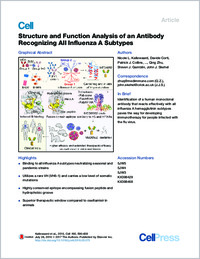Structure and function analysis of an antibody recognizing all influenza A subtypes
- Kallewaard, Nicole L. Department of Infectious Disease and Vaccines, MedImmune LLC, One MedImmune Way, Gaithersburg, USA
- Corti, Davide Humabs BioMed SA, Bellinzona, Switzerland
- Collins, Patrick J. Mill Hill Laboratory, The Francis Crick Institute, London, UK
- Neu, Ursula Mill Hill Laboratory, The Francis Crick Institute, London, UK
- McAuliffe, Josephine M. Department of Infectious Disease and Vaccines, MedImmune LLC, One MedImmune Way, Gaithersburg, USA
- Benjamin, Ebony Department of Infectious Disease and Vaccines, MedImmune LLC, One MedImmune Way, Gaithersburg, USA
- Wachter-Rosati, Leslie Department of Infectious Disease and Vaccines, MedImmune LLC, One MedImmune Way, Gaithersburg, USA
- Palmer-Hill, Frances J. Department of Infectious Disease and Vaccines, MedImmune LLC, One MedImmune Way, Gaithersburg, USA
- Yuan, Andy Q. Department of Antibody Discovery and Protein Engineering, MedImmune LLC, One MedImmune Way, Gaithersburg, USA
- Walker, Philip A. Structural Biology Science Technology Platform, Mill Hill Laboratory, Francis Crick Institute, London, UK
- Vorlaender, Matthias K. Mill Hill Laboratory, The Francis Crick Institute, London, UK
- Bianchi, Siro Humabs BioMed SA, Bellinzona, Switzerland
- Guarino, Barbara Humabs BioMed SA, Bellinzona, Switzerland
- De Marco, Anna Humabs BioMed SA, Bellinzona, Switzerland
- Vanzetta, Fabrizia Humabs BioMed SA, Bellinzona, Switzerland
- Agatic, Gloria Humabs BioMed SA, Bellinzona, Switzerland
- Foglierini, Mathilde Institute for Research in Biomedicine (IRB), Faculty of Biomedical Sciences, Università della Svizzera italiana, Switzerland
- Pinna, Debora Institute for Research in Biomedicine (IRB), Faculty of Biomedical Sciences, Università della Svizzera italiana, Switzerland
- Fernandez-Rodriguez, Blanca Institute for Research in Biomedicine (IRB), Faculty of Biomedical Sciences, Università della Svizzera italiana, Switzerland
- Fruehwirth, Alexander Institute for Research in Biomedicine (IRB), Faculty of Biomedical Sciences, Università della Svizzera italiana, Switzerland
- Silacci, Chiara Institute for Research in Biomedicine (IRB), Faculty of Biomedical Sciences, Università della Svizzera italiana, Switzerland
- Ogrodowicz, Roksana W. Structural Biology Science Technology Platform, Mill Hill Laboratory, Francis Crick Institute, London, UK
- Martin, Stephen R. Structural Biology Science Technology Platform, Mill Hill Laboratory, Francis Crick Institute, London, UK
- Sallusto, Federica Institute for Research in Biomedicine (IRB), Faculty of Biomedical Sciences, Università della Svizzera italiana, Switzerland
- Suzich, JoAnn A. Department of Infectious Disease and Vaccines, MedImmune LLC, One MedImmune Way, Gaithersburg, USA
- Lanzavecchia, Antonio Institute for Research in Biomedicine (IRB), Faculty of Biomedical Sciences, Università della Svizzera italiana, Switzerland - Institute for Microbiology, ETH Zurich, Switzerland
- Zhu, Qing Department of Infectious Disease and Vaccines, MedImmune LLC, One MedImmune Way, Gaithersburg, USA
- Gamblin, Steven J. Mill Hill Laboratory, The Francis Crick Institute, London, UK
- Skehel, John J. Mill Hill Laboratory, The Francis Crick Institute, London, UK
-
21.07.2016
Published in:
- Cell. - 2016, vol. 166, no. 3, p. 596-608
English
Influenza virus remains a threat because of its ability to evade vaccine-induced immune responses due to antigenic drift. Here, we describe the isolation, evolution, and structure of a broad-spectrum human monoclonal antibody (mAb), MEDI8852, effectively reacting with all influenza A hemagglutinin (HA) subtypes. MEDI8852 uses the heavy-chain VH6-1 gene and has higher potency and breadth when compared to other anti-stem antibodies. MEDI8852 is effective in mice and ferrets with a therapeutic window superior to that of oseltamivir. Crystallographic analysis of Fab alone or in complex with H5 or H7 HA proteins reveals that MEDI8852 binds through a coordinated movement of CDRs to a highly conserved epitope encompassing a hydrophobic groove in the fusion domain and a large portion of the fusion peptide, distinguishing it from other structurally characterized cross- reactive antibodies. The unprecedented breadth and potency of neutralization by MEDI8852 support its development as immunotherapy for influenza virus-infected humans.
- Language
-
- English
- Classification
- Medicine
- License
- Open access status
- hybrid
- Identifiers
-
- RERO DOC 329941
- DOI 10.1016/j.cell.2016.05.073
- ARK ark:/12658/srd1319400
- Persistent URL
- https://n2t.net/ark:/12658/srd1319400
Statistics
Document views: 237
File downloads:
- Fulltext: 482
